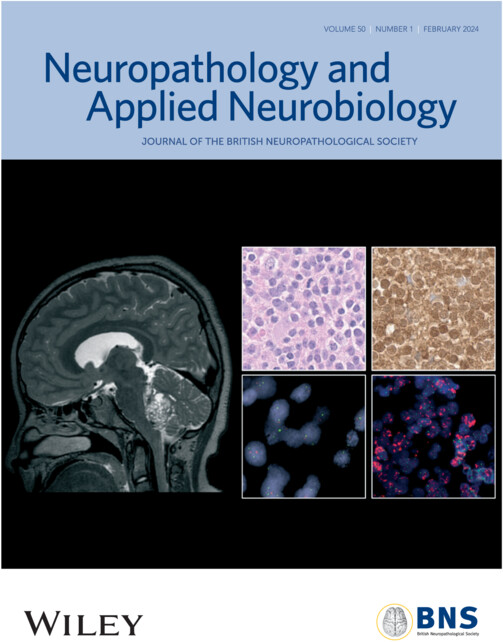Rapid bacterial identification from formalin-fixed paraffin-embedded neuropathology specimens using 16S rDNA nanopore sequencing.
IF 4
2区 医学
Q1 CLINICAL NEUROLOGY
引用次数: 0
Abstract
Bacterial infections of the central nervous system (CNS) can be severe, life-threatening diseases. Early detection of causative pathogens is crucial for the rapid administration of a tailored antibiotic regime. However, microbiological cultures are negative in one third of bacterial CNS abscesses [1], and routine neuropathology diagnostics are typically limited to histological staining techniques such as Gram or Warthin-Starry. Moreover, tissue might not have been submitted for microbiological culture at the time of surgery in cases without a preoperative suspicion of CNS infection. Molecular diagnostics using pathogen-specific PCR provides an alternative diagnostic approach and has been successfully applied to formalin-fixed paraffinembedded (FFPE) tissue samples [2] but is hypothesis driven and thus requires a priori suspicion of the causative pathogen. Metagenomic sequencing of the bacterial 16S rRNA gene represents an unbiased alternative and has been successfully applied to study the bacterial metagenome of brain abscesses based on DNA extracted from unfixed specimens [3, 4]. Here, we introduce a rapid and scalable approach for bacterial pathogen detection from FFPE specimens using nanopore sequencing of 16S rDNA amplicons. FFPE samples of 32 bacterial CNS infections (31 brain abscesses and 1 subdural empyema) and 3 control samples (reactive brain tissue) were retrieved from our archive. Clinical data and microbiological culture results were compiled by reviewing patient records. After DNA extraction, multiplex PCR with four primer sets covering variable regions 3–7 of the 16S rRNA gene was performed (see the supporting information). PCR products were sequenced on a nanopore Mk1c device. After basecalling, raw fastq files were uploaded on the EPI2ME platform (Metrichor Ltd., Oxford, UK), and results were loaded into the R environment for further analysis (supporting information). Raw sequencing files are available under the BioProject Accession No. PRJNA899355 (ncbi.nlm.nih.gov/bioproject/899355). The median age of the 8 females and 24 males was 57 years (range 13–84 years). Preoperatively, a diagnosis of bacterial CNS infection has been suspected in 24 patients (75%), whereas a malignant tumour was radiologically considered in six cases (19%); in two patients, the aetiology of the lesion had been unclear (Table S1). On Gram staining, bacteria were identified in 23 samples (72%). All cases had positive bacterial cultures, and 10 samples (31%) showed mixed infections with up to three taxa. Deep 16S rDNA nanopore sequencing yielded 31,706 classifiable reads per sample (median, interquartile range: 18,255–40,901). To control for potential sources of contamination, we additionally sequenced four no-template PCR controls (NTC) and three reactive brain tissue samples (median depth: 27,077 reads). Taxonomic classification of the controls revealed Brachybacterium, Brevundimonas and Bradyrhizobium as the most prevalent genera accounting for >90% of reads (Figure S1). To further evaluate these taxa’s influence on metagenomic classification, we sequenced five serial dilutions (range from 1:10 to 1:10) of a sample with a monoinfection of Nocardia abscessus (sample 1). With subsequent dilutions, metagenomic profiling revealed an increase in contaminating reads Received: 30 September 2022 Revised: 9 November 2022 Accepted: 13 December 2022采用16S rDNA纳米孔测序技术对福尔马林固定石蜡包埋神经病理标本进行快速细菌鉴定。
本文章由计算机程序翻译,如有差异,请以英文原文为准。
求助全文
约1分钟内获得全文
求助全文
来源期刊
CiteScore
8.20
自引率
2.00%
发文量
87
审稿时长
6-12 weeks
期刊介绍:
Neuropathology and Applied Neurobiology is an international journal for the publication of original papers, both clinical and experimental, on problems and pathological processes in neuropathology and muscle disease. Established in 1974, this reputable and well respected journal is an international journal sponsored by the British Neuropathological Society, one of the world leading societies for Neuropathology, pioneering research and scientific endeavour with a global membership base. Additionally members of the British Neuropathological Society get 50% off the cost of print colour on acceptance of their article.

 求助内容:
求助内容: 应助结果提醒方式:
应助结果提醒方式:


